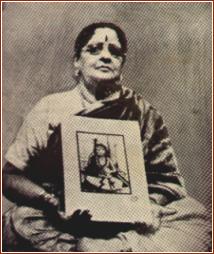MUSIC
BANGALORE
NAGARATHINAMMAL - THYAGA SEVA SAKTHA ...............(Nov.3, 1878 - May
19, 1952)
from The Garland series by Mr.N.Rajagopalan

The
great lady of Bangalore belonged to the fragrant period which saw a galaxy
of illustrious women musicians like Veena Dhanammal, Salem Meenakshi, Enadhi
Lakshmi Narayani Sisters, Coimbatore Thayee, Bangalore Thayee, Tiruvarur
Rajayee and Kolar Nagarathinam. The trio MSS, DKP, MLV joined them later.
But Bangalore Nagarathinammal was altogether of a different type in that
she was able to look beyond herself and music rendition and focus her attention
on the source of such resplendent music. Her sublimated soul envisioned
the Cauvery and its music - soaked cultured waters not only at Tiruvaiyaru
but at the distant Mercara where lies its source. Others came, sang and
left. But her genius perceived something greater, enduring and substantial.
She enjoys the unique distinction of having surrendered her all to the
service of the Great Bard of Tiruvaiyaru, Tyagaraja.
With single-minded devotion and dedication,
she sold her properties, pooled her income and enlisted the support of
all to commence the construction of the Samadhi of Tyagaraja on the bank
of the Cauvery on October 27, 1921 and performed the Kumbabishekam
on January 7, 1925. She started the annual celebrations (aradhana) on a
firm and grand scale. The samadhi lands were donated by Sri Mannapa Saheb
and Sri Rajaram Mannaji Surve. And she spent her last years there giving
lessons on Tyagaraja songs at the 'Tyaga Brahma Nilayam', a dedicated construction
work in which the eminent cine actor, Chittoor V.Nagayya played the principal
role. Quite fittingly, her samadhi is located near the samadhi of the bard.
Another wish fulfilled. Nagarathinammal was an amalgam of sterling character,
obsessive and noble dedication to good causes held dear to her heart and
of dharmic conduct. Devoted to her gurus, she performed guru poojas
annually and also celebrated Hanumat Jayanthi. She was chosen specifically
to sing a Sanskrit invocation at the All India Sanatana Dharma Conference
in 1929. She gave a large number of concerts and the bulk of the proceeds
went for the construction of the Tyagaraja Samadhi and the Mysore Choultry
at Tiruvaiyaru for the benefit of Kannadigas.
Born at Mysore, of Vakil Subba Rao
and Puttulakshmi, she learnt Sanskrit and music under Giripatta Thimmayyah
and violin from her uncle Venkitasami Appa of Bangalore. Had further training
in violin under Munuswamy Appa, a disciple of Wallajahpet Krishnaswami
Bhagavathar. Her desire for knowledge was so intense that she learnt Bharatanatyam
under Bangalore Kittanna and Abhinaya from Madras Tiruvenkatachariar. Her
over-all vidwat was polished of by Bidaram Kittappa. Puttulakshmi was discarded
first by Subba Rao and later by Thimmayyah also. But she bore her trials
and brought up her daughter with an iron will. With multi-sided acomplishments,
Nagarathinam made her debut significantly at Veena Seshanna's house in
her fifteenth year. Palaces and Institutions availed of her immense training
and talent both in India and in Sri Lanka. It is said that she gave 1235
engagements between 1905 and 1934, which is equivalent to ten times that
now.
She enjoyed a 'gambhira' voice.
Her infatuation with the songs and life of Tyagaraja was so intense and
sublime that she executed a will on January 3, 1949 setting apart her assets
to construct the Samadhi and to run a gurukula at Tiruvaiyaru to propagate
the Bard's songs. There was Yaga, Yoga, Tyaga and Bhoga with nadopasana
in her life of suffering and achievement.
Her only daughter died. Her attempt
to adopt a girl failed. Her sufferings while young and these failures tended
only to harden her admiration for Tyagaraja, the Prince of Renunciation,
and her resolve to accomplish and achieve what all others had ignored.
Her intense love of his songs was matched only by her passion for Devaranamas
and to demonstrate that Purandara songs could also be sung likewise in
such an elaborate and scholarly manner, she arranged a concert of Bidaram
Krishnappa at Madras to be covered only by Devaranamas. Mysore Vasudevacharya
says, 'Ragalapana, Swarakalpana, neraval, everything was there as in a
traditional concert. The audience felt delighted. They realised for the
first time that the Kannadigas also have their own individualistic heritage'
She rarely rendered the kritis of
Dikshitar as she felt that she would not be able to do justice to them
because of her inadequate knowledge of Sanskrit. Tyagaraja and Purandaradasa
had won her heart so fully that it had no space for others!
Publications:
Her publications include Madhyapanam
in Telugu, Sri Tyagaraja Ashtothra Namavali in Sanskrit and Panchee
Karana Bowdheeka in Tamil.
Nagarathinammal reprinted the Telugu
classic 'Radhika Swayamvaram' of Muddu Palani, a courtesan of the
18th century. Police seized all the copies taking objection to its high
eroticism. Only in 1947 the ban was lifted. There was a fresh edition in
1952.
Titles and Honours:
March 6, 1949 - Tyaga Saktha by
President of India
Vidya Sundari by Puranam Suryanarayana
Tirthar
1932 - Gana Kala Visaradha by Kaviraja
Krishnamurti Sastri.
Nagarathinammal needs no better honour
than the appreciation and gratitude of the thousands who gather annually
at Tiruvaiyaru for the Aradhana. 'Earn, Conserve, Distribute', this is
my life-mission, declared the Founder of the Annamalai University. The
application of the principle to the life of Nagarathinammal reveals that
she belongs to the galaxy of eminent women of India. Literally she got
dissolved in every respect in nadopasana!
Tyagaraja
Aradhana
Saint Tyagaraja;
'Fragrant Gold of Carnatic Music' from A Garland by Shri.N. Rajagopalan
The Pancharatna
Kritis
|